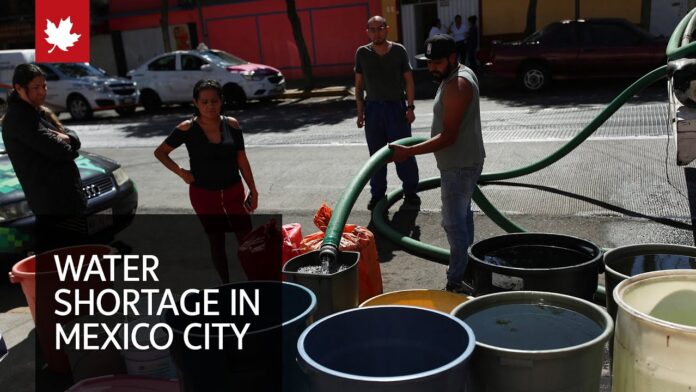Experts warn Mexico City could run out of water by June 26 without rain, amid severe drought and infrastructure issues
Mexico City faces a looming water crisis, with the potential to run out of drinking water by June 26. This event, referred to by locals as “Day Zero,” has been exacerbated by three consecutive years of low rainfall and high temperatures. The Cutzamala water system, which provides water to millions, currently operates at only 28% capacity.
Three years of insufficient rainfall and escalating temperatures have plunged Mexico City into a severe water crisis. The Cutzamala system, essential for supplying water to the city, is alarmingly low. According to the North American Drought Monitor, the federal district containing Mexico City was classified as “severe” as of April 30.
Despite local politicians downplaying the crisis, many neighbourhoods have already experienced water shortages. Residents fear “Day Zero” could arrive as soon as June 26. The Cutzamala system, described by the Mexican government as “vital to the lives of millions,” typically moves about 15 cubic meters of water per second and serves approximately 22 million people. Now, it operates at a mere 28% capacity.
In addition to low rainfall, crumbling infrastructure has worsened the situation. Nearly 40% of Mexico City’s water is lost due to leaky pipes and other infrastructural issues. Gabriel Quadri de la Torre, a federal congressman for Coyoacán, stated that fixing these problems would cost billions, a sum the city struggles to allocate.
Experts emphasize the urgent need for rain. However, Christina Boyes, a professor at the Center for Economic Research and Teaching in Mexico City, warned that rainfall might create a “false sense of security.” She stressed the importance of sustainable water management practices to address the crisis effectively.
Researchers from the National Autonomous University of Mexico proposed solutions in a recent study. They suggested intensive water capture, using treated residual water for agriculture, and refilling aquifers with surface water. These measures could potentially save the Cutzamala system, but the estimated cost of implementing these solutions is $5 billion.
In February, Mexico’s National Water Commission announced several projects to improve the Cutzamala system and mitigate water loss. These initiatives include enhancing infrastructure reliability, encouraging private company participation in the water network, and implementing rainwater harvesting in schools. These efforts aim to supplement the city’s dwindling water supply.
The crisis highlights the broader issues of water management and climate resilience. As Mexico City grapples with immediate needs, the situation underscores the necessity for long-term solutions to ensure sustainable water resources for its millions of residents.
Analysis
The unfolding water crisis in Mexico City raises several critical issues. Politically, the government’s response to the crisis has been under scrutiny. Local politicians initially downplayed the severity, possibly to avoid panic or criticism. However, this approach may have delayed necessary actions, exacerbating the situation. The federal and local governments now face immense pressure to find and fund solutions, a challenging task given the economic constraints.
Economically, the cost of addressing the infrastructure problems and implementing sustainable water management practices is staggering. Gabriel Quadri de la Torre’s estimate of billions of dollars to fix the leaky pipes highlights the financial burden. Furthermore, the $5 billion cost to implement the study’s recommendations presents another significant economic challenge. These costs could strain public resources and require substantial investment from private entities and international aid.
Sociologically, the crisis has a profound impact on the daily lives of Mexico City’s residents. Water shortages disrupt basic activities, creating stress and uncertainty. The crisis disproportionately affects marginalized communities, who may lack the resources to secure alternative water supplies. This exacerbates existing social inequalities and highlights the need for equitable water distribution systems.
From a local perspective, the crisis has sparked community-driven initiatives. Residents and local organizations are likely advocating for rainwater harvesting and other conservation practices. These grassroots efforts play a crucial role in mitigating the immediate impacts and fostering a culture of sustainability.
Gender and race considerations also emerge in the analysis. Women often bear the brunt of water scarcity, as they are typically responsible for household water management. The crisis could amplify their burdens, affecting their health and well-being. Additionally, indigenous and marginalized communities, who may already face discrimination and limited access to resources, suffer disproportionately during such crises.
The theoretical perspectives on the crisis emphasize the intersectionality of environmental, social, and economic factors. The water crisis is not just an environmental issue but a complex problem intertwined with governance, infrastructure, and social equity. Addressing it requires a holistic approach that considers all these dimensions.
In conclusion, Mexico City’s water crisis is a multifaceted issue requiring urgent action and long-term solutions. The government’s initiatives, while necessary, must be complemented by community engagement and sustainable practices. Only through a collaborative and comprehensive approach can Mexico City hope to navigate and overcome this critical challenge.
